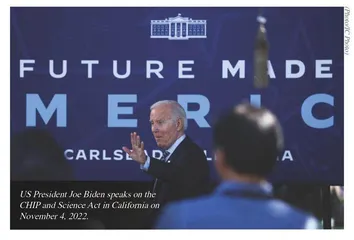The Biden Administration’s Strategy of Economic Diplomacy
作者: Li Wei

Since Biden took office as the US President, he has shifted his focus from the so-called “free market economy” to government-led economic diplomacy. He builds exclusive economic alliances in the industrial chain, advanced technology, infrastructure and digital trade, with the fundamental purpose of forging a united front against China economically and changing the status quo of the global market by the hand of government. Through these measures, the US seeks to revitalize its domestic economy and, in the meantime, ratchet up economic competition with China. This will profoundly affect the geopolitical and economic circumstances of China’s development and security.
The Biden Administration’s Economic Diplomacy Strategy Aims to Contain China
Biden took office at a time when the US was faced with numerous daunting challenges both at home and abroad, and has since pushed ahead with a broad policy agenda including an economic strategy, which is composed of industrial support policy at home and economic alliance diplomacy abroad. In terms of industrial policy, his administration passed the Infrastructure Investment and Jobs Act, CHIPS and Science Act and Inflation Reduction Act successively by virtue of the Democratic Party’s majority in Congress. The three Acts represent a major victory of the Biden administration in economic legislation and constitute the core of Bidenomics. Their aim is to boost so-called onshore production, revive local manufacturing and thus strengthen the economic competitiveness of the US on a global scale.
Such an economic strategy cannot go without the cooperation of allies and partners. On account of that, the Biden administration vigorously promotes economic diplomacy at both the global and regional level, attempting to build a new international economic alliance under the banner of so-called economic security. And by aligning it with the so-called “democratic alliance”, the administration is architecting a two-pronged foreign strategy.
At the global level, the US focuses on supply chain resilience and infrastructure building. In terms of supply chain diplomacy, it hosted two related global conferences, namely the Global Summit on Supply Chain Resilience convened by Biden himself in November 2021, and the Supply Chain Ministerial Forum co-chaired by US Secretary of State Blinken and Secretary of Commerce Raimondo in July 2022. Both meetings drew the participation of countries that are highly relevant to global supply chain, reflecting the US’ ambition to build a supply chain alliance and lead the efforts to reshape supply chain.
In terms of infrastructure diplomacy, the US formally announced at the G7 summit in June 2022 to launch the so-called Partnership for Global Infrastructure and Investment (PGII) which was born out of the 2021 Build Back Better World (B3W). Biden announced further that the US would raise $200 billion for PGII over the next five years and seek to raise $600 billion for global infrastructure investment together with G7 countries.
At the regional level, the Biden administration rolled out an economic diplomacy strategy in full swing in the Indo-Pacific, the Atlantic, the Americas and the South Pacific Island region. The Indo-Pacific Economic Framework (IPEF), as Biden’s main economic competition mechanism against China in the Asia-Pacific, has been joined by 14 member countries so far. It aims to ensure supply chain resilience and strengthen cooperation in clean energy, digital and technology sectors. Its four key pillars of trade, supply chain, clean energy, tax and anti-corruption correspond to a connected economy, resilient economy, clean economy and fair economy respectively. With its unveiling the US fills up the missing part of the economic cooperation mechanism in its Indo-Pacific strategy, showcasing its intention to reshape regional economic order and revive its regional economic leadership, which will disrupt the existing RCEP and CPTPP-based economic cooperation pattern in the region. Chip 4 is another economic alliance the US is trying to build in Indo-Pacific. As a semiconductor industry-based alliance that covers the whole industrial chain including design and manufacturing, it attempts to lure economies with advanced semiconductor manufacturing capabilities such as the ROK, Japan and Taiwan and wall off China from the global semiconductor supply chain.
The Biden administration unfolded its economic diplomacy in Europe as well. In June 2021, Biden and European Commission President Ursula Von der Leyen announced the establishment of the US-EU Trade and Technology Council (TTC) at the US-EU summit in Brussels. In a way, the TTC resurrects in a new form the Transatlantic Trade and Investment Partnership (TTIP) that died from the disagreement between the US and EU, and meanwhile includes technical cooperation into it besides trade. In September 2021, the US and the EU co-hosted the first TTC ministerial meeting in Pittsburgh, marking the inauguration of the TTC as a new mechanism for transatlantic economic cooperation. At this meeting, the two sides reached consensus on five areas of cooperation, namely advancing investment review, multilateral export control, rules for research, development and application of artificial intelligence technologies, semiconductor supply chain resilience, and addressing challenges posed by non-market economies. In May and December 2022, the two sides held the second and third ministerial meetings in Paris and Maryland respectively, which further improved the mechanism.